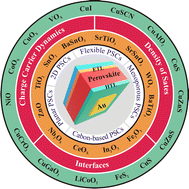Understanding the role of inorganic carrier transport layer materials and interfaces in emerging perovskite solar cells
Abstract
In the last decade, organic–inorganic hybrid and metal halide perovskite materials have shown tremendous tunability properties and capacity to harvest solar energy efficiently via conceptually new solar cell architectures. Presently, third-generation thin-film solar cells employing perovskite light absorbers produce a power conversion efficiency of ∼25%, which is attributed to their exceptionally unique and device-worthy optoelectronic properties. Although the perovskite light absorbers play a main role in the harvesting process, the corresponding device architectures must contain other backing layers such as electron and hole transport layers, which are crucial for the efficient and stable electronic functioning of the solar cell. Thus, understanding the functional significance of these transport layers and synergistically optimizing them with respect to the perovskite light absorbers is highly significant for further developments in this arena. Therefore, this review focuses and critically analyses the electron and hole transport layers used in perovskite solar cells, highlighting their functional significance and critical role. Their functionality basically originates from their crystal structure, chemistry, electronic and optical properties, and compatibility with the corresponding synthesis protocols of perovskites. Overall, this work aims at developing a comparative analysis and enhanced understanding of the transport of photogenerated charges across the active interfaces in the perovskite solar cells.

- This article is part of the themed collection: Showcasing recent research in materials chemistry from IIT Bombay, IIT Indore and IISc


 Please wait while we load your content...
Please wait while we load your content...